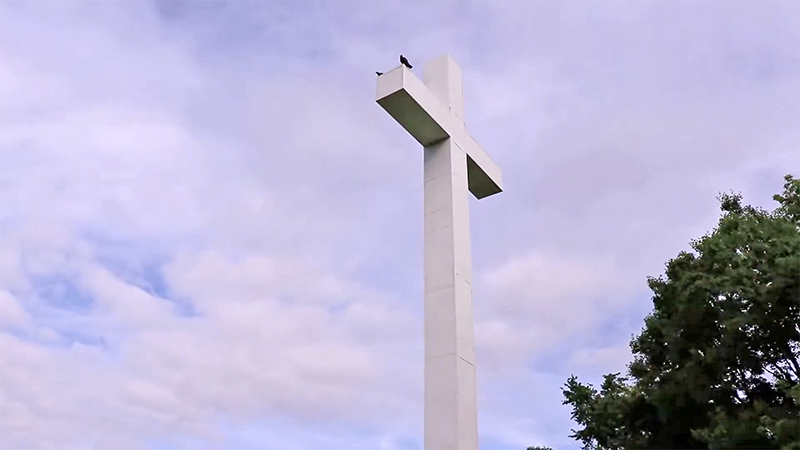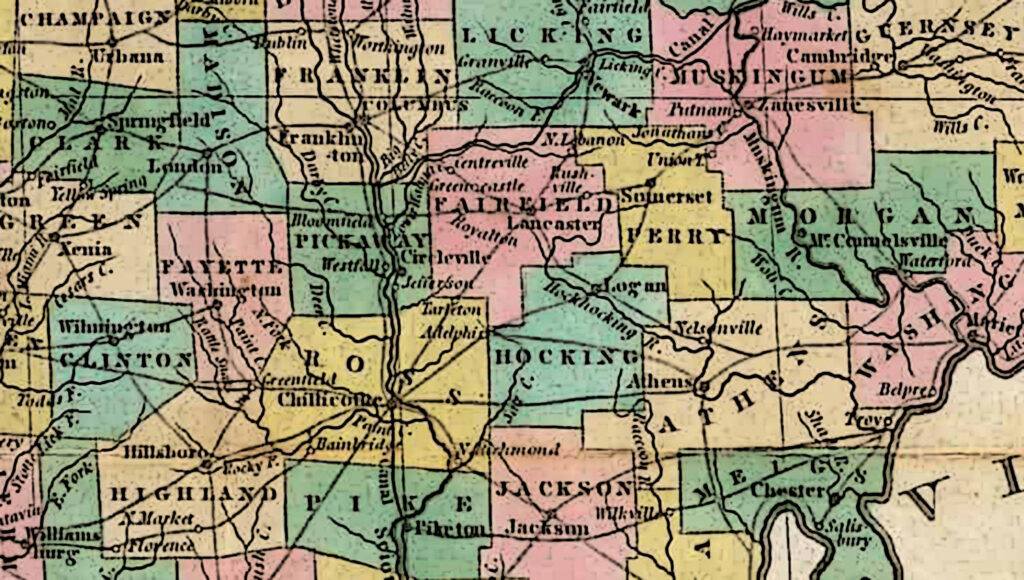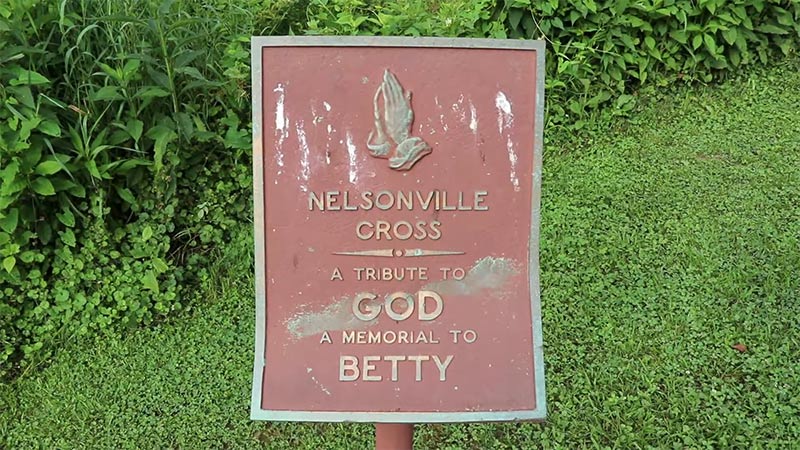If you’ve taken road trips around the US, chances are good that you’ve seen a cross on a hill. A single man from West Virginia erected nearly 2000 of them around the country. For a time in her life, Robin Caldwell had to drive past the 65 ft.-tall Nelsonville Cross near Athens, Ohio, but what was a symbol of love and peace to some was a source of fear and menace to her, until she came to see it — and the people of southeastern Ohio — in a new light.
The Nelsonville Cross in Nelsonville, Ohio, sits on top of a hill. A very high hill. Daytime or night, it was the scariest thing to witness, especially if you were a heathenish Black teenager from Cleveland, Ohio. A real city girl who rarely attended church and didn’t want to be reminded of Jesus or lynchings. I was enjoying the freedom of freshman year at neighboring Ohio University, and that cross only served to kill my vibe. If it didn’t involve shaking my behind at Black frat and sorority dances, eating pizza every other day, and hanging out at “Boy Central” or the College Green, I wanted nothing to do with it.
But I had received “The Talk” at home, and Black upperclassmen shared enough lore about that cross, the Klan, and how to move about in the county. I understood the parameters of my freedom.
According to my granddad, there was one road I needed to know: the road that would lead me home alive. That would be US-33 West. He believed that was the safest way, with a multitude of places to stop before taking a northern route to Cleveland. The only problem with his plan was that I had to go through Nelsonville and see that cross.
On the way home to Cleveland for a weekend visit, you would have thought we were being hit by a hailstorm of bullets, when a car backfired. I yelled “Shit!” and thought “sniper” as I hightailed it out of a gas station in Nelsonville with my boyfriend and his cousin, the driver. From my crouched position in the backseat, I looked up at the hill bearing that cross, wondering how something so precious to my religious great-grandma could also symbolize harm and hatred.
That was at 17. Fast forward to several years later, when I was a graduate student, driving that same road in and out of that same town. More mature and armed with a few “big girl” experiences in the city, such as suffering through the telling of cringey jokes in the workplace, training supervisors with less education, and overhearing a waitress whisper “n—r” under her breath after I politely asked her to service my table. Little did I know there would be more of that later in life, but at the time of my return, these interactions led me to pursue better.
Some of that better was found in the quiet hills off of SR 32. I lived in a four-unit apartment building, an anomaly surrounded by farmland, a few houses and the woods. It was part sanctuary and part remedy for any distracting temptation I had in town. The peace and quiet were welcome. I’d only drive out of those hills to go to class, to work, to hang out, to shop and to leave town.
Regularly, I’d drive from Athens through Nelsonville to study in Columbus on The Ohio State University campus. I also taught at a prison near the state capitol, which made driving past the cross unavoidable.

Though I was no longer a heathen by my best estimation (Jesus was now my friend), that cross continued to make me feel a bit uneasy. The people, though, did not, because by that time I had pretty much figured out that humans were complicated. Some could be kind just because and a few were just outright insufferable. Plus, there was the issue of my own issues, which enabled me to extend a grace that could be both dismissive of the ignorance and somewhat tolerant, knowing I would some day leave.
From my undergraduate days, I remembered a rumor that the Grand Dragon of the KKK lived in Nelsonville. I knew they had a branch office or rally bureau — whatever they call it — nearby, because I’d seen them passing out propaganda to the students.
One spring quarter, I attended a Klan rally in Parkersburg, West Virginia, just over the state border, under the ruse of getting video footage for class. My friend D, a classmate and an experienced videographer who shot footage in Gaza with bullets flying over her head, and I romanticized what it would be like to be on the frontlines of a hot racist mess. In truth, there was no class assignment; we were both simply curious and decided to go as a team.
We were nervous on the way to Parkersburg. We discussed everything from protecting our eyes in the event we were bombed by teargas, to finding each other if pandemonium broke out, to “tell my family I love them” instructions should one of us perish. We also knew that I would be the first one to freeze up when it was time to run, so I had to promise to let her lead.
We pulled up at the site of the rally, parked, looked around and quickly realized all of our jitters, planning and dreams of a Pulitizer were for naught. It was one of the most uneventful rallies ever.
I expected — and wanted — drama like Oprah found in Forsyth County, Georgia, replete with confederate flags waving and “Go back to Africa” signs and lots of venomous yelling. There wasn’t one thing that looked like we’d ever seen on television, not even a Bull Connor. If the rumored Grand Dragon was there, he was unrecognizable. The only other Black person at the rally, who appeared to be leaving, told us that Parkersburg law forbade the Klan from wearing hoods and regalia during rallies. They had to show their faces. The only person I recognized was a white anti-Klan protester suspected of being a Vietnam draft dodger hiding in Athens County. He called me and my friend “ignorant,” because we dared to engage a Klansman in conversation. He smelled like onions. I had to politely tell the “ally” that he was out of line and insulting. Hell, I’m being nice. I told him to step off.
The Klansman was young and relatively easygoing. He answered our questions like a champ. I asked him everything but “Who’s your mama?” Curiously, he volunteered that he joined the Klan because he didn’t like that all the jobs were being taken by immigrants and “the coloreds.” I asked him what he did for a living and he said he was a farmer.
“Is an immigrant or a ‘colored’ trying to take your farm?” He said no. Did any immigrants or coloreds actually own farms in the area? Most of the immigrants and “coloreds” I knew in the region worked at the university or were students and professors. There were a few others working at hotels and stores in low-paying jobs. A handful owned little restaurants, and I knew he wasn’t trying to cook Mexican, Thai or Greek food. That child made me tired.

I stood there, feeling a bit childish for wanting that rally to be a spectacle, while pondering something one of the Black elders at my church in Athens shared about the region. Parkersburg along with Marietta and Belpre, Ohio were stops on the Underground Railroad. Adam Clayton Powell, Sr. and Booker T. Washington spent time in the region. Powell preached at my church as a young man while Washington married a woman from Athens County. This was not the Appalachia of Lil’ Abner and every conceivable stereotype.
My thoughts were interrupted by the young Klansman saying something about “Americans,” and that’s when it hit me. I am an American. Born and raised in the United States. A voter. A taxpayer. Most of the men in my family served in the military.
“Do you know the words to the Star-Spangled Banner?” I asked.
He chuckled and said no. Mind you, I didn’t know all of the words to the Star-Spangled Banner, but I’d mouth it as needed.
“Look, you seem like a decent man,” I said. “I bet if you saw me lying on the side of the road, you’d check on me and help. Am I right?”
He said yes.
I thought, young and dumb, which is what that protester thought of me. The Klansman knew his own mind like I knew my own, so I stopped selling him short. His decision to belong was as willful as my decision to be all peace, love, and Soul Train. After I sighed and surveyed the scene, I noticed that the oniony draft dodger was staring in our direction, as were the Klanspeople. It was our cue to leave.
D and I thanked him for his time and honesty, wrapping up my first and last Klan rally experience. We didn’t have much in the way of video footage but we had a story to tell. We also had a lot to process during our drive back to Ohio and Athens County. Thankfully, this experience was between the two of us, more about our own ambitions, so we owed no explanations.
But we certainly had a lot of questions. How could someone promote something that warred against his own goodness? What made the Klan equate American nationalism with white skin? And, why didn’t we just leave when the other Black person left?
A few weeks later, my grandmother died. It was sudden. It was heartbreaking and after the funeral I sojourned back to Athens not the same.
Life was a series of blurry vignettes. I recall smiling and laughing. Falling into a crying, heaving heap in the grocery store, staring at a shelf of canned soups. Sleeping in the middle of a day only to wake up in the middle of the night, gasping for air. Breathing, not breathing. Living but dying on the inside.
That’s grief.
Have you ever been lost, but know exactly where you are?
That’s grief in Southeast Ohio. Appalachian grief. My grief in a place that had become home, albeit a temporary home.
I would be in the middle of a crying fit, when I’d have to stop my car on a back road to pick up a turtle and move it out of my way, or painfully wait at a crossroad to let two dogs finish having “relations” from one side to the other. One time I was coasting down a hill and my car rolled right over a water moccasin. (It was fine. I was not.) Coming home to find a raccoon resting in front of my door answered a lifelong question: yes, I can scream like they do in the movies. Grief keeps going, even through animal encounters, because God knows my human encounters were limited due to self-isolation.
But not forever. One pitch-black evening, I was bending over to gather groceries off of my backseat, and was nose-goosed by the dog who lived down the lane. He was saying hi. I could hear toads and crickets but I hadn’t heard my neighbor’s black lab-St. Bernard mix, Claymore, walking across my driveway’s gravel. After he goosed me, I jumped into the car and saw nothing but yellow eyes until mine focused. Bless him, that sweet boy resuscitated my broken heart, a heart that had leaped into my throat, still pumping.
As the days and weeks passed, I started socializing with humans more. I needed them too, right? The problem was I was stuck way past the 21 days to make or break a habit phase and Elisabeth Kübler-Ross’s Five Stages of Grief. Grief was my new normal and hanging around people who were happy made me uncomfortable…for them.
There were four women — two Black and two white — who showed me the generosity often expressed in the region though not often received by outsiders. In a way I can’t describe, it was easier to be around them and not feel like a burden or energy zapper.
Three were Appalachian born and bred, and one was a transplant who was more town than gown yet affiliated with the university. The four friendships — unlikely relationships — left me with more than I could ever return.
My Appalachian pals taught me about the culture and how to appreciate everything from its endogamy (everyone seemed related) to its foodways to hidden histories to how to empathize with the people. It was almost like my grandmother willed them to me. Some years later, I would learn that my grandparents had kin in Athens County, and that I was a cousin to some of the white and Black residents. It all made sense. The hospitality shown to me was what I’d grown up witnessing and living. We didn’t identify as Appalachian, never said it out loud, but those roots showed up in earthiness, warmth and comfort. It was simpler to say we were Northerners with Southern history, but my DNA and family tree said “Appalachia” from the hills of Virginia to Ohio to Tennessee, Kentucky and West Virginia.
Lori, a white woman of Scottish descent, often had me ride with her to the small towns enveloping Nelsonville, and we had to pass that cross. I told her how I felt about it and how it scared me, and she laughed.
“The Klan didn’t have anything to do with it. A man built that for his late wife,” she said.
She took the time to drive me up there. The grounds were idyllic and lovely. Relief washed over me when I figured out it would be next to impossible to go all sniper from the foot of that cross. It would take a couple of hours for it to register, but it was the first time I enjoyed a good belly laugh at myself without stifling the joy.

Suzanne, a woman who lived on a small farm down the lane, also showed me great affection and care. Besides handing me a business card for grief counseling services, she gave me other gifts like long morning walks throughout the countryside and experiences like riding a horse and driving her tractor. Thanks to this lady, I learned how to crawl underneath barbed wire to avoid cow chips in a pasture. I also learned how Quakers worship and would attend meetings with her. The physical activity became enough for me to sleep better at night.
Violet and Irene were my Black elder friends. One look at Violet and I would remember all that I’d lost. She looked like my grandmother, my great-grandma and aunts — the women who formed me and taught me that it’s okay to be me. One conversation with Irene, reminded me of the simplicity of smelling rain in the air, listening to birds chirp and sitting still to catch a breeze. Violet grew up in Athens and attended the university. Irene lived up in Kilvert, a community of WINs (white, Indian, Negro) people or what we now call tri-racial isolates. Both taught me what it was like to be Black in rural Appalachia. The two were even related by marriage. Irene was old enough to be my mother and Violet was like a surrogate grandmother to me. Between them I learned local Black history, about family connections, and how they as Black women negotiated racism in the region.
Lori, Suzanne, Violet and Irene were my safe spaces as I started to manage my grief better with counseling.
And just when I was depending on my four friends the most, my time was up. I had to leave Athens to pursue work and become my grandfather’s caregiver in Cleveland.
Just before leaving town, I drove up to that cross, all by myself. I walked around, examined the enormity of the structure, and sat a spell to meditate. The man who built it had no idea that it would be the focus of conjecture and defamation. That a Black girl — now a woman — would ever be afraid of it, thinking she could potentially swing from it. That people could look at the same thing, in the same place, and see it in such different ways. That I would ever question if I’d stop for that Klansman to help him on the side of the road. His decency was no longer a concern, but my own decency needed examination. Yet, he would be comforted knowing that the thing he endeavored, the giving of hope and peace, I would receive one day.
At the cross, at the cross where
I first saw the light,
And the burden of my heart rolled away
It was there by faith I received my sight,
And now I am happy all the day!
Happy-ish. Most days.
Top image: Vintage postcard from Nelsonville, Ohio, with a double rainbow over the train depot (c. 1910). See the full image.
